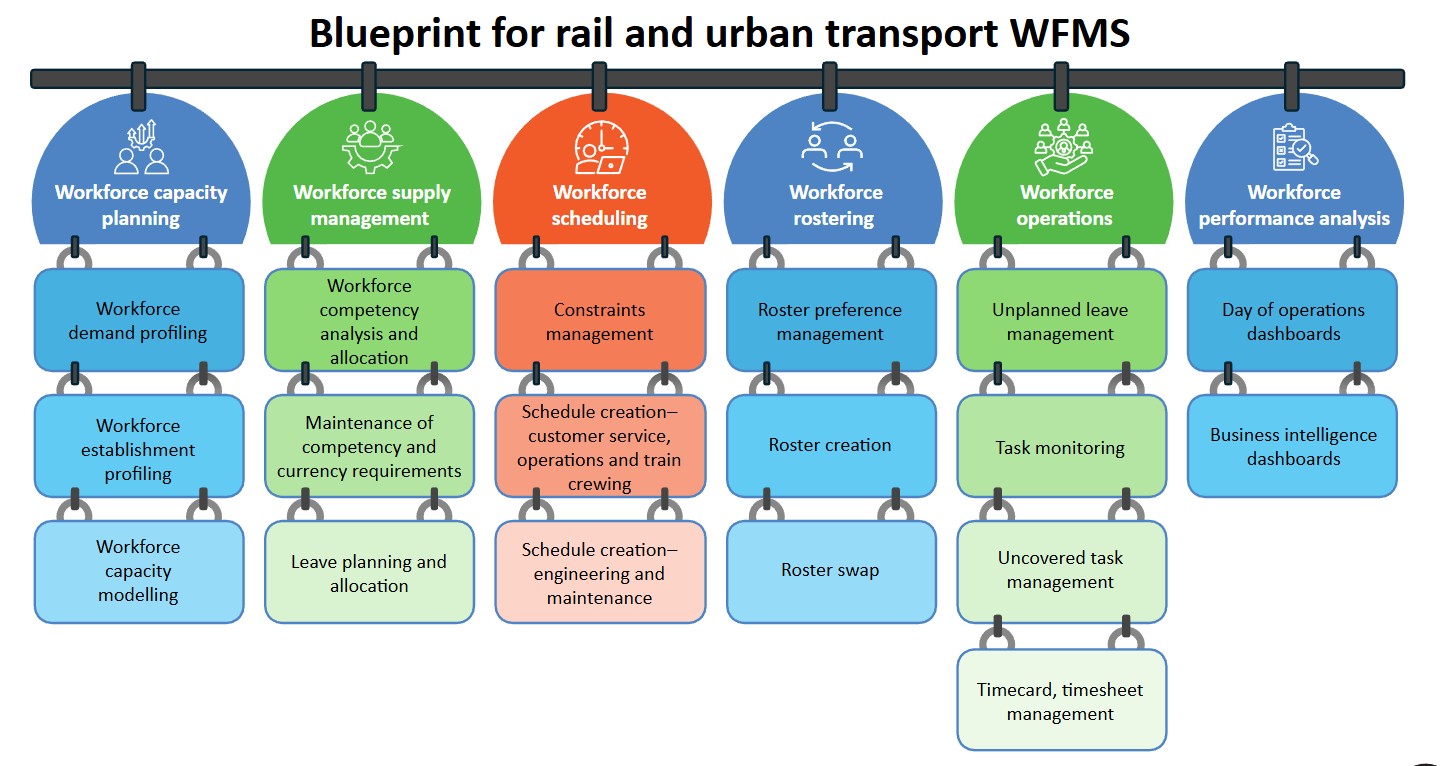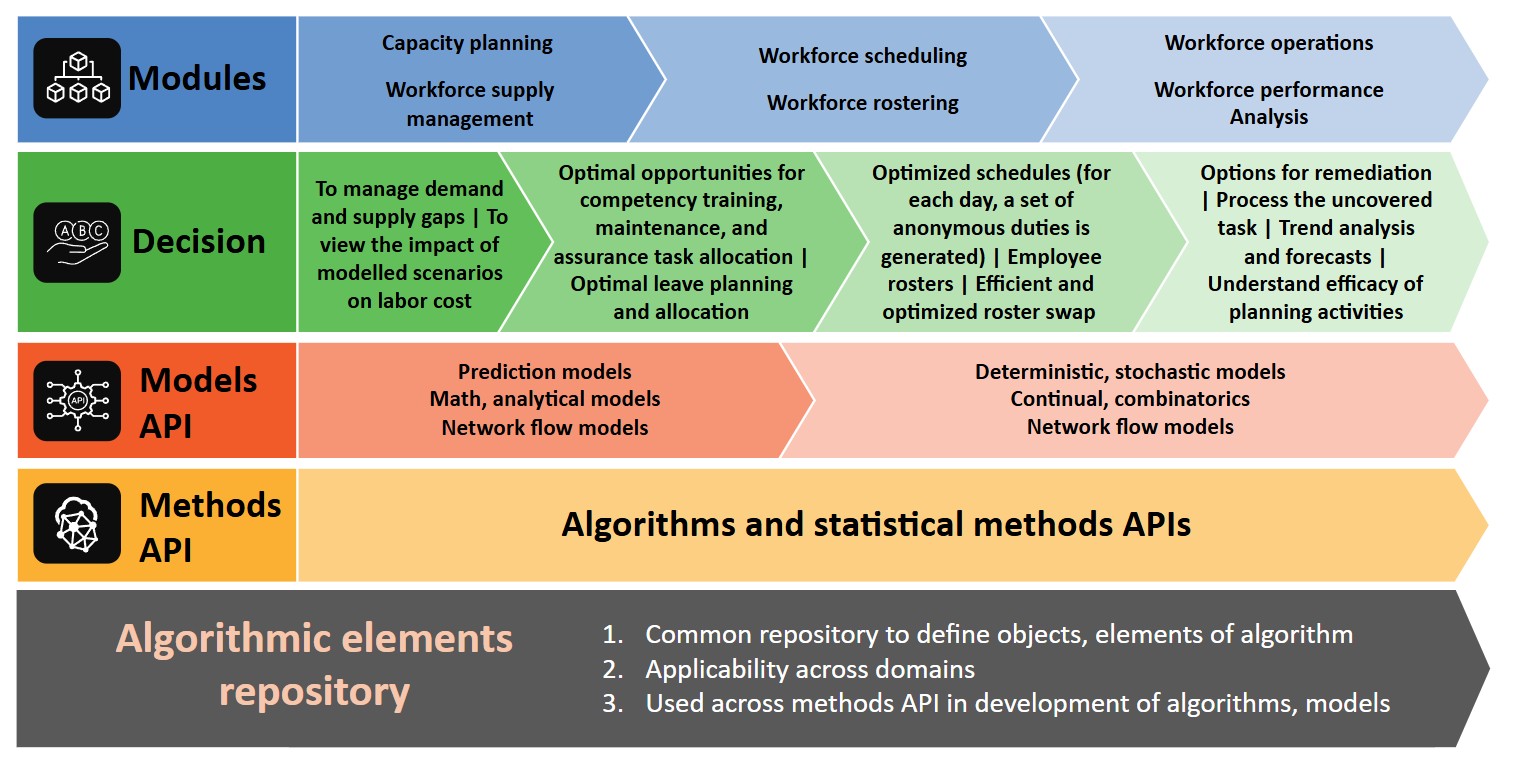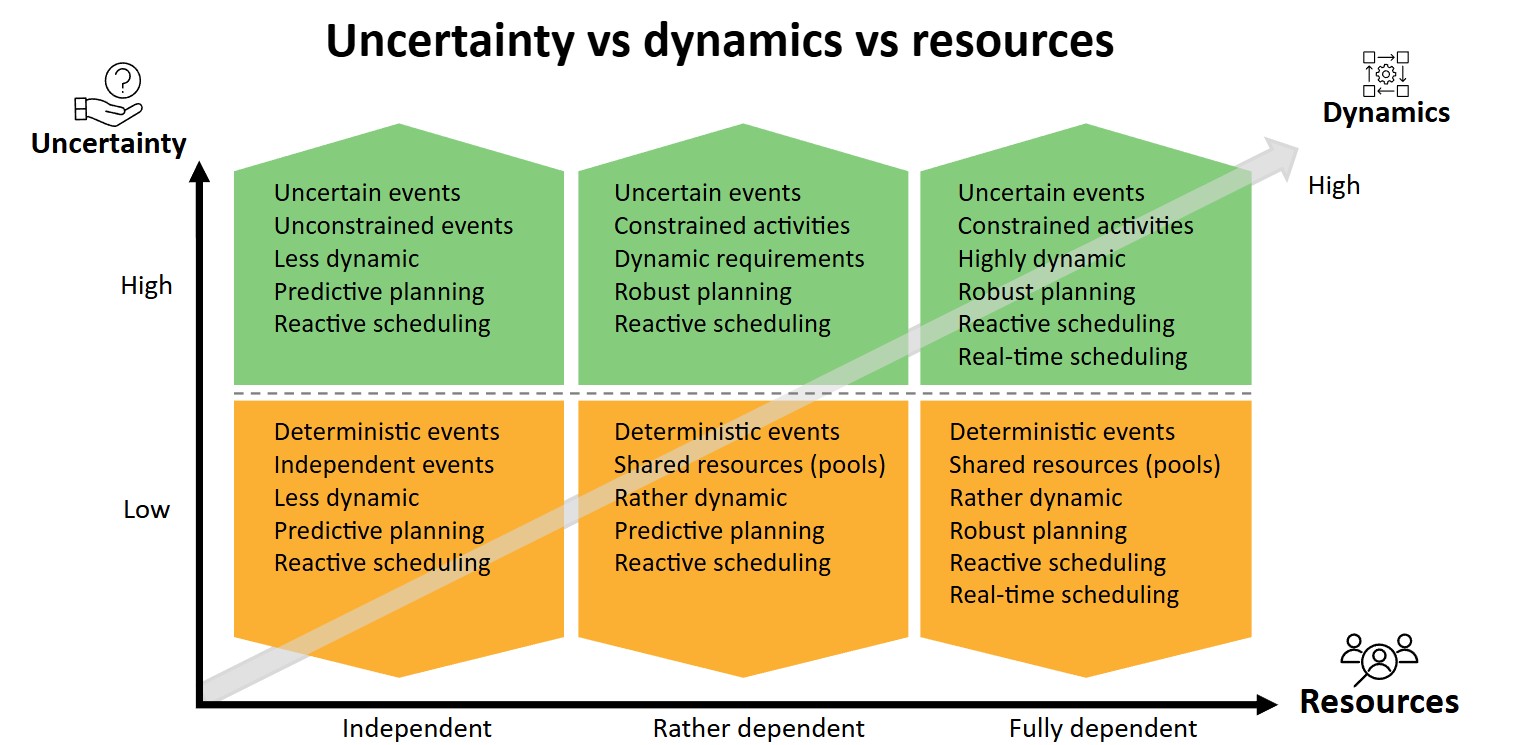Industries
HIGHLIGHTS
- Transport organisations face workforce challenges such as onboarding skilled workers, retention, managing aspirations, meeting preferences, and adhering to labour agreements.
- Effective strategies to efficiently plan and manage station staff, field crews, and maintenance teams sustainably is, therefore, critical.
- A detailed approach using domain capabilities and a layered framework will help address these challenges.
On this page
Dynamic systems
Workforce typically accounts for a significant portion of the total operating cost in rail and urban transport organisations.
In railway organisations, the workforce, including specialised drivers, maintenance engineers, and operations staff, operates under demanding conditions with dynamic and flexible business requirements. Besides uncertainties from external factors like tourism, events, and regional business needs, transport organisations face challenges such as staff retention, onboarding skilled workers, managing employee aspirations, meeting work preferences, and adhering to labour agreements.
It is critical to manage workforce effectively since railway operations are influenced by staff preferences, employee agreements5, role flexibility, technological trends, and a balance between skilled workforce supply and sustainability. Moreover, evolving trends indicate transportation workforce will need broader skills to meet the demands of new technologies, multi-modal options, and autonomous operations.
Strategies to efficiently plan and manage station staff, field crews, and maintenance teams sustainably is, therefore, the need of the hour. A detailed approach using domain capabilities and a layered framework will help address these issues effectively.
Shifting from the earlier predefined practices to evaluating decisions in a modular context, considering system certainty, uncertainty, dynamism, and resource dependencies, will support employee-centric workforce planning. The dynamic environment allows for integration of larger language models (LLMs) with constraint-based optimisation and reasoning.
Workforce planning and rostering needs
Given the centrality of staff in operations, workforce management systems (WFMS) are receiving increased attention in the rail and urban transport sectors.
Organisations are seeking to enhance methods for incorporating employee preferences and improving employee interactions by focusing on decision elements, resource dimensions, and employee considerations.
The table below outlines various decision elements, resource dimensions, and employee aspects that are crucial for effective workforce planning and rostering. It includes factors such as forecasting, event prediction, workload estimates, real-time requirements, and legal regulations. The table emphasises the importance of incorporating employee preferences, multi-skills, and role choices to enhance job satisfaction and operational efficiency.
Decision elements |
Resource dimensions |
Employee aspects |
Forecasting Event prediction Workload estimates Workload movements Real-time requirements Alerts Gantt charts |
Budgeting Capacity planning Staff scheduling Crew rostering Back-office scheduling Union, state rules Legal regulations |
Time and attendance Leave management Empowerment
|
Table 1 – Framework for workforce management
The table below focuses on the integrability of language models with decision support systems, highlighting the need for scalable solutions that can adapt to different employee sizes, locations, and job tasks. It also addresses corporate control, cloud hosting, web-based and mobile apps, and management dashboards. The table underscores the significance of data privacy, system security, and access controls in ensuring robust and secure workforce management systems
Data science perspective |
IT deployment expectations |
Solution scalability
Integrability of language models with decision support systems Corporate control |
Cloud hosting Web-based and mobile apps Management dashboards Run-time redundancies Data privacy System security Access controls |
Table 2 – Key Considerations for WFMS Solution
In this article, we present an alternative perspective on the modularisation of decisions. The text describes how planners may use data science to implement mixed duties and cyclic rosters as practical approaches for fairness, stand-off, and relief duties, which can support employee requirements and manage uncertainties. Grouping employees into a pool can improve the matching of individual preferences with roles and connect short-term assignments with long-term career objectives. This approach offers a method for addressing business needs by connecting predictive, reactive, and real-time planning and scheduling with strategic and tactical planning using LLMs. As a result, improving the robustness of the planning ecosystem is important to support reactive and real-time decision-making.
Domain dimensions
In rail and urban transport, customers prefer a single solution for generating staffing plans and deployment schedules.
They want:
- Station staff in customer service directorates
- Operations centers and signaling departments in customer operations
- Fleet, network, and civil infrastructure in engineering and maintenance planning
- Train crew and services directorate
With advancements in computing speeds, workforce solutions have become more affordable, offering hosting options and modular components (see Figure 1).
The traditional approach in the urban and rail transit industry involves deploying full-scale, ready-to-use solutions with a deployment time of about four to six months. Customer interactions have revealed a need for customisable architectural design with:
- Inclusion of employee and organisational preferences early in workforce planning
- Configurable shift templates, staffing options, work priorities, and career aspirations mapping
- Staffing definitions for roles and skills, and resource pooling for shared services
We need to adopt agile and innovative deployment methods to achieve optimised workforce planning (see Figure 2).
The evolving workforce market has led to the grouping of employees based on various factors such as skills, experience, and aspirations. This enables management to effectively cross-deploy personnel across different roles and responsibilities.
Solution options with choices
Innovative practices in the industry are experiencing rapid changes, with agility serving as a key factor for design, evaluation, testing, and deployment.
An agile architecture identifies essential modules to cover decision choices and define as well as solve problems to enable decision support (see Figure 2).
Development support may also come from ready-to-use algorithms found on open-source platforms or commercial solutions. When selecting these, factors such as scalability, responsiveness, deployment options, and associated costs should be taken into account, along with the following considerations:
Addressing legal preferences and adherence effectively Considering legal, union, and company-related preferences, such as training, onboarding, equal opportunities, and rotation-based systems Managing employee preferences to prevent changes in the roster Incorporating organisational preferences, such as central vs independent scheduling, workforce uberisation, cross-deployment, impacts, and opportunities. The rail industry requires workforce planning that prioritises employees from the outset. More broadly, these are the core needs of the sector:
Prioritise employee self-service to achieve cost optimisation and enhance operational efficiency Let staff manage rosters within business guidelines
- Factor in employee work preferences when scheduling
- Use integrated tools for roster monitoring and disruption management
- Fix inefficiencies with mobile access, self-service, workflows, and digital channels
- Apply skill-based scheduling, accounting for experience and career goals
- Continually include employee preferences in roster planning
- Boost efficiency using real-time monitoring and alerts
- Focus on automation, self-service, business intelligence, and optimisation engine integrated with LLMs.
Navigate uncertainties
A business's responsiveness to market needs depends on foreseeing operational dynamics to ensure dynamism, especially during uncertainties, and also on resources.
Figure 3 shows the link between dynamism, uncertainty, and resources.
Domain services define workforce offerings with flexible modules and options, meeting the evolving requirements of people management practices.
Transit systems with predictable passenger demands experience less uncertainty, as shown in the lower left part of Figure 3. In contrast, the top right of Figure 3 represents business districts where external factors like traffic jams and peak hour spillovers heavily influence passenger patterns. Sudden increases in passengers due to weather or road traffic compel rail systems to deploy more trains. Dynamic scheduling and robust plans are, therefore, necessary for responsive planning.
Conclusion
Technological trends and autonomous operations are creating a need for multi-modal transportation that integrates data from various digital interfaces within the ecosystem, including transportation system users.
This ongoing evolution requires systems that are modular, adaptive, and agile, allowing for customisation and configuration based on socio-geographical-cultural-business requirements. With large language models (LLMs) being increasingly viewed as key to technology adaptation, it is important to integrate language models with optimisation and reasoning processes across organisations to meet workforce deployment needs.



